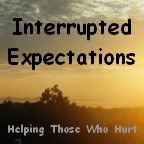
I am
a mid-30s, homeschooling mom of three energetic children. To look at me you would never guess that I’ve lived with invisible chronic illness since my teen years. I “look” perfectly normal. Chronic low-grade fevers give my cheeks a rosy glow. I usually take great care in the way I dress and apply
makeup because feeling bad is hard enough, I really don’t want to “look the part” too. And no, you’ve probably never seen me on a really bad day because if I can’t get out of the house, or even out of bed, well you don’t see me out and about on those days!
There are occasions when my illness refuses to remain invisible, like when I gratefully pull into a handicap parking spot, relieved for every single step I can cut from my errands as I stagger under debilitating exhaustion or when each step sends searing pain through my body. Or maybe it is still invisible even then, because I sure get some strange looks as I climb out of the van and unload my three, none of us in obvious need of that blue license plate! I can understand the confusion on their faces, for even my closest friends don’t realize what I’m facing until I share with them my daily reality. Still my heart stings to think those parking lot strangers might believe I’m abusing a privilege that I anything but take for granted!
I could claim many labels including Chronic Fatigue Immune Dysfunction Syndrome (CFIDS), Myalgic Encephalomelitis (ME), fibromyalgia (FM), human herpesvirus six (HHV-6), multiple chemical sensitivities (MCS), Temporomandibular Joint (TMJ) and several others. But today it isn’t my severe and persistent fatigue, tender/swollen lymph glands, impaired memory and concentration, headaches, sleep disturbances, sore throat, joint or muscle pain that I’m here to talk about. Today I want to share about the heartache of my “other” invisible illness…
Infertility. Yes, I know I introduced myself as a mom of three. And yes, they are all our biological offspring. I’m still in awe to have three precious miracles, spaced almost exactly three years apart each time. No one would guess that it took us seven years, one confirmed (and several suspected) miscarriage(s) and much medical aid to have our first; another two years, two miscarriages, extensive surgery and medication to conceive the second; or that between the three pregnancies I spent 26 weeks on bedrest fighting to carry them each close enough to term to give them a chance at healthy, live birth.
You would never know, looking at these three, that not only do they have multiple siblings awaiting them in Heaven due to my miscarriages, but that we also tried to build our family through adoption seven different times. Each time we were left with empty arms and broken hearts. Adoption is a wonderful experience that I still hope God may someday have in store for our family, but for many reasons it is certainly not an “easy answer” to infertility!
While many people think of infertility as simply the inability to have children, this invisible chronic health concern often impacts much more than just reproductive organs. For women, endometriosis, polycystic ovarian syndrome (PCOS), and multiple other causes of infertility can lead to debilitating pain, extreme cycle irregularity with hormonal imbalances that can significantly impact insulin levels, weight, emotional stability, and greatly increase cancer risks. Deep cystic acne, excessive hair growth (in all the wrong places), and increased chance of miscarriage should conception ever occur, are also all concerns linked to certain causes of infertility. While I am a mom of three living miracles now, many of the medical issues surrounding our years of barrenness remain daily concerns for my current and long-term health picture. A couple’s infertility is just as often due to male-factor causes as female ones, and men also face unique health issues as a result of reproductive challenges.
Infertility isn’t just “not being able to get pregnant.” It is a medical condition that is almost always invisible, and as you might imagine, can become extremely complicated to manage for those of us who also face other chronic health conditions, as one set of medications and side-effects interacts with another! Just as any other chronic health challenge cannot be wished away, infertility is not simply solved by “relaxing” or going on vacation or having my husband wear boxer shorts. Studies have shown that the stress and depth of grief experienced by many infertile couples is parallel to that of cancer patients. So next time you are in a social setting and trying to get to know a new friend, why not open with, “Tell me about yourself,” rather than asking the question dreaded by every infertile woman, “Do you have any kids?”
I’m so thankful to be involved in National Invisible Chronic Illness Awareness Week because I can’t always tell someone’s story just by looking at what seems to be the obvious! As we all become more aware of one another’s struggles, hopefully we can become a more caring and compassionate people.
-----------------------
Jennifer Saake has lived with endometriosis since puberty and fibromyalgia since high school. She experienced the dramatic onset of CFIDS/ME her freshman year in college, 18 years ago this September. After dropping out of school and spending most of the next two years in bed, she married her sweetheart, Rick, who saw her as more than just an illness. Together they struggled to grow their family through a decade of infertility and multiple losses, including the diagnosis of PCOS with insulin resistance.
Jenni is the co-founder and Director Emertis of
Hannah's Prayer Ministires, an international support ministry for families facing fertility challenges, and is the author of
Hannah’s Hope: Seeking God’s Heart in the Midst of Infertility, Miscarriage & Adoption Loss (NavPress, 2005).
http://www.HarvestingHope.blogspot.comhttp://www.HannahsHopeBook.comHannah's Prayer Ministires at http://www.Hannah.org






